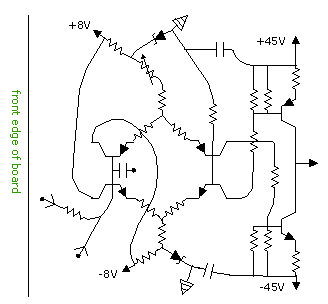 |
New Audio Amplifiers PC Boards Complex digital circuits are generally put on perforated boards, because many wires have to cross. But where discretes are used, etched boards are incomparable for space saving and clean circuitry. The techniques that I use create high density boards. If other techniques are used, more space would usually be required. I don't use wire wrapping for digital boards. Instead, I run the wires on top of the board, between the sockets, and attach them to solder tail sockets by making one loop around the pin. Good pointed tweezers are required. Two or three connections can be made to a single pin. There is a hazzard; prying off the wires with an iron for debugging can break pins. Copper clad perf board would be preferable. The wire could then be soldered to the copper rather than the pins. Of the myriad of patterned perf boards that are available, none are quite ideal for the purpose. They should have one or two holes beside each pin, and two lines down the center of the chip for supply voltages.
Notice that there are two places where wires cross near the input. That is done by drilling holes and jumping wires over the top. Board Pattern for Quad Input Amplifier Core type solder should be avoided at all times. Besides being messy and ineffective, it's slow promoting heat damage. Liquid rosin is very fast and efficient. It's applied with a toothpick, while the solder is picked up on the tip of the iron, which frees one hand. The electronic switching is controlled with soft touch momentary switches. Nowdays, various types of posts are available on those switches. Back in the old days (1986), I had to glue pieces of quarter inch rods (from poteontiometer shafts) onto flat swithces using epoxy. It is recomended that the entire current amplifier be constructed on an aluminum plate which is attached to the back panel for cooling. Then there is not a clutter of wires going back to the boosters; and the absence of long wires makes ringing easier to control. With the bridge amplifier, four boosters for each channel were attached to one aluminum plate. The aluminum plates are elevated about 8mm or more by making a double bend on the sides. The boosters are attached directly to the aluminum using mica insulators, while everything else is on a pc board.
Two boards were used - one under the main board for insulating it. The lower one was also used for stabilizing the booster leads. The lower one was copper side up (mostly etched away), and the upper one was copper side down. The lower one was attached by screws on the ends; and the upper one was held in place by the wires only. A few wires were extra heavy for that purpose. The bridge amplifier could have been put in a little larger box; and then the dimensions of the plate could be a little larger. (Figure) Boxes |
|
|||||||||
|
Box for 10W Amplifier, Compact (Lab amp) 7 x 5.5 x 2.5 inches (W D H)
Box for Bridge Amplifier 12.25 x 7.5 x 3.25 inches. (W D H)
Box for 90V Amplifier 15.5 x 10 x 4.5 inches (W D H)
|
|
End View 
There are few alternatives for the design of the boxes. They must be rectangular with fixed front and back panels; and the sides should open with the lid for accessibility. The few with such a design being sold in the catalogues are not very large; so they might have to be constructed from aluminum sheet metal, which is available from the heating and cooling shops, if a metal shop is not nearby. Harmonic distortion is so low in these amplifiers that it is not a significant consideration. The primary reason why HD is used as a statistic with audio amplifiers is because the output of the usual design oscillates. Removing the oscillation is difficult and expensive. If it is not entirely removed, the residual oscillation creates harmonics. To minimize labor, potentiometers can be used for variable gain. To prevent the need for multiple input capacitors, the potentiometer can replace the feedback resistor rather than the input resistors. The current load is then calculated from the input resistor. Assuming a normal signal to be ±1 volt, and an optimum load to be 1mA, a 1K input resistor could be used, and the coupling capacitor would be 220µF. If you are wondering where to get parts, the largest selection is Digi Key. The second is Mousers. page one | contents
|
|





